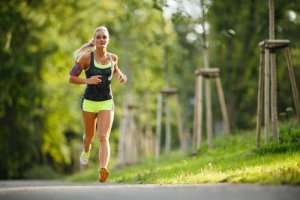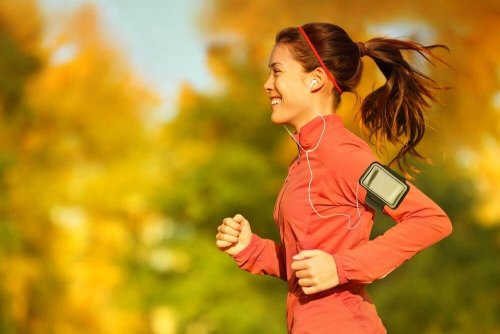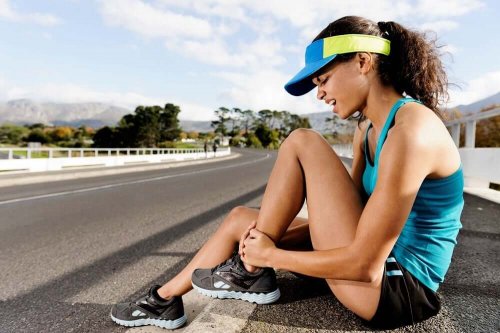Physical Exercise and the Menstrual Cycle


Written and verified by Nursing Daniel Baldó Vela
The menstrual cycle begins with the manifestation of the typical vaginal bleeding and ends when it reappears during the next cycle. In between, a series of phases occur whose hormonal characteristics directly affect athletic performance. These are the changes that we’re concerned with when we talk about physical exercise and the menstrual cycle.
Roughly speaking, we can say that the menstrual, ovulatory, and premenstrual phases involve high physiological stress and affect athletic performance. In contrast, it seems that the phases immediately preceding and succeeding ovulation most benefit the practice of physical exercise.
Physical exercise and the menstrual cycle
The menstrual cycle lasts about 28 days and consists of the follicular phase (menstrual and preovulatory), ovulatory phase, and luteal (postovulatory and premenstrual) phase. In each of these phases, women present certain physical and psychological characteristics that are related to their hormonal levels and directly impact the practice of physical exercise.
Discover: What Does the Color of Menstrual Blood Reveal About Your Health?
Below, we’ll tell you what happens during each phase of the menstrual cycle, how they influence athletic performance, and what’s the best training option for each case.

Menstrual phase
This is the first phase of the cycle, which lasts about five days and is characterized by menstrual bleeding. At this stage, estrogen, progesterone, and testosterone levels are low. Furthermore, as a result of the bleeding, blood iron levels drop and cardiac frequency increases at rest.
The changes we described can result in:
- Low mood.
- Sleep disorders.
- Fatigue.
- Increased perceived exertion.
- Fatigue threshold reduction.
- Increased risk of injury.
- Increased reaction time.
- Less coordination and dexterity.
During these days, it’s best to take it easy and give priority to your welfare above physical exercise. To maintain an active lifestyle and improve your mood, it’s advisable to include light and pleasant outdoor walks under the sunlight.
Preovulatory phase
Preovulation is the second phase of the follicular phase. This phase lasts about nine days. During this time, estrogen levels elevate. Consequently, the woman’s mood is optimal and the rapid use of energy (ATP and glycogen) is more efficient. Therefore, it’s the perfect time to do HIIT (high-intensity interval training) metabolic workouts.
Ovulation
Ovulation is the second phase of the cycle. It only lasts one day and may cause pain. Here, estrogen and testosterone are at their maximum concentrations and, as a result of this, the woman feels stronger than ever. During this phase, it’s best to opt for workouts focused on maximum force.
However, beware! The hormonal changes we described involve excess neuromuscular laxity that increase the risk of injury.
Ovulation is the stage of the menstrual cycle in which the most physical injuries, especially knee injuries, occur.

The luteal phase
This phase represents the onset of the end of the cycle and lasts about nine days. Here, in addition to a high concentration of estrogen, progesterone levels increase as well. Progestogens improve the use of fat as an energy fuel. Thus, you should ideally opt for low-intensity high-duration aerobic exercises, such as running, walking at a moderate intensity, and cycling, among others.
Premenstrual phase
The premenstrual phase is the last phase of the cycle. It precedes menstruation, lasts approximately five days, and is characterized by hormone level drops. Here, the so-called premenstrual syndrome often appears.
Discover: How to Put an End to Premenstrual Syndrome Once and for All
At this stage, stress levels are often high and there’s a worsened mood. This is due to drops in serotonin levels, associated with a drop in progesterone levels. Also, fluids are retained, the psychomotor skills necessary for proper performance are affected, and appetite increases. According to the characteristics of this last phase, it’s best to opt for activities that help release tension and keep you calm. Some good examples are yoga, tai chi, and pilates.
Conclusion
As you can see, each menstrual cycle phase has its own unique characteristics that directly impact the practice of physical exercise. Thus, it’s essential to coordinate physical exercise and the menstrual cycle to perform at your full capacity in the healthiest way possible.
All cited sources were thoroughly reviewed by our team to ensure their quality, reliability, currency, and validity. The bibliography of this article was considered reliable and of academic or scientific accuracy.
- Aguilar Macías, A.S. (2015). ¿Cómo afecta el ciclo menstrual al rendimiento deportivo en atletas? Rev Arch Med Camagüey, 19(3): 203-5. Consultado el 27/11/2019. Recuperado de: http://scielo.sld.cu/scielo.php?script=sci_arttext&pid=S1025-02552015000300001
- Arias Moreno, E.R. & Martínez Beníted, J.E. (2018). Variabilidad en el rendimiento físico de las jugadoras de fútbol según las fases del ciclo menstrual. Revista Digital de Educación Física, 9(51): 11-30. Consultado el 27/11/2019. Recuperado de: https://dialnet.unirioja.es/servlet/articulo?codigo=6360319
- Konovalova, E. (2013). El ciclo menstrual y el rendimiento deportivo: una mirada al problema. Rev UDCA Act & Div Cient, 16(2): 293-302. Consultado el 27/11/2019. Recuperado de: http://www.scielo.org.co/pdf/rudca/v16n2/v16n2a02.pdf
- Ramírez Balas, A. (2014). Efectos de las fases del ciclo menstrual sobre la condición física, parámetros fisiológicos y psicológicos en mujeres jóvenes moderadamente entrenadas [tesis doctoral]. Universidad de Extremadura, España. Consultado el 27/11/2019. Recuperado de: https://dialnet.unirioja.es/servlet/tesis?codigo=44394
- VV.AA.( 2019). Rol de los estrógenos en la génesis de los trastornos dolorosos músculo-esqueléticos articulares. http://www.scielo.edu.uy/scielo.php?script=sci_arttext&pid=S1688-93392019000100070
This text is provided for informational purposes only and does not replace consultation with a professional. If in doubt, consult your specialist.








